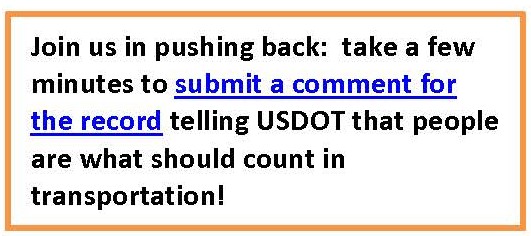The Safe Routes Partnership submitted our official comments for the record on May 16. Read our comments here.
What the US Department of Transportation chooses to measure has an impact on which transportation projects get built in your state and community—and on your ability to feel safe while walking and bicycling to school and in your neighborhood.
Several years ago, in the MAP-21 transportation law, Congress charged the USDOT with creating a system of performance measures for which state departments of transportation (DOTs) and major metropolitan areas will set goals for improvement – and then fund and build transportation projects that make progress towards those goals.
Unfortunately, in the newest batch of proposed performance measures, the US Department of Transportation is saying that what matters is moving as many cars as quickly as possible—and that people walking, bicycling, and taking transit aren’t even worth counting.
 The draft rule proposes to measure the “performance” of our transportation system as well as congestion and freight movement by counting how fast cars are moving. There are eight proposed measures—and seven of them exclusively look at the speed of cars and trucks or traffic delays on major roads, many of which bisect small towns or are critical thoroughfares in our cities. (The eighth is about traffic-related air pollution.)
The draft rule proposes to measure the “performance” of our transportation system as well as congestion and freight movement by counting how fast cars are moving. There are eight proposed measures—and seven of them exclusively look at the speed of cars and trucks or traffic delays on major roads, many of which bisect small towns or are critical thoroughfares in our cities. (The eighth is about traffic-related air pollution.)
Why is this focus on speed to the exclusion of all else an issue?
- It means that our “transportation system” in the eyes of the USDOT means roads and cars, not people and all the modes of transportation that make up that system. And it forces that view on state and city DOTs that will have to use these measures to track their progress.
- It doesn’t acknowledge that when people walk, bike, or take transit that they are reducing congestion by avoiding single-occupancy car trips—and that they need safe alternatives to roads to do so.
- By prioritizing speed and free flow of traffic, state DOTs will end up expanding roads and increasing vehicle speeds. That makes it more dangerous for people walking and biking and harder for people to even cross the street to catch a bus or a streetcar. And it will leave little money to build sidewalks, bike lanes, crosswalks and transit accommodations.
- By only counting cars and trucks, the rule also fails to address equity concerns. Many low-income people walk, bike, or take transit—and their needs would be completely overlooked in this rule.
The draft rule also looks at reductions in air pollution from transportation projects. Another area in which USDOT misses an opportunity with this rule is to measure greenhouse gas emissions emitted by cars and trucks—and emissions that could be avoided by shifting people out of cars and onto transit, bikes, and their feet.
We believe in accountability for our transportation dollars—but forcing states and cities to measure only one aspect of our transportation system will be devastating to efforts to create safe, healthy, and vital cities and towns. We just prevailed in our efforts to make sure that the safety performance measure included the safety of people biking and walking. Now, we must prevail again to make sure more than cars count!
The Safe Routes Partnership is working with a number of other national organizations to push back on this misguided approach. But, we need your help. USDOT needs to hear from thousands of people around the country so they will pay attention and completely revamp these proposed measures. Please take just a few minutes to submit a comment for the record telling USDOT that people are what should count in transportation!

